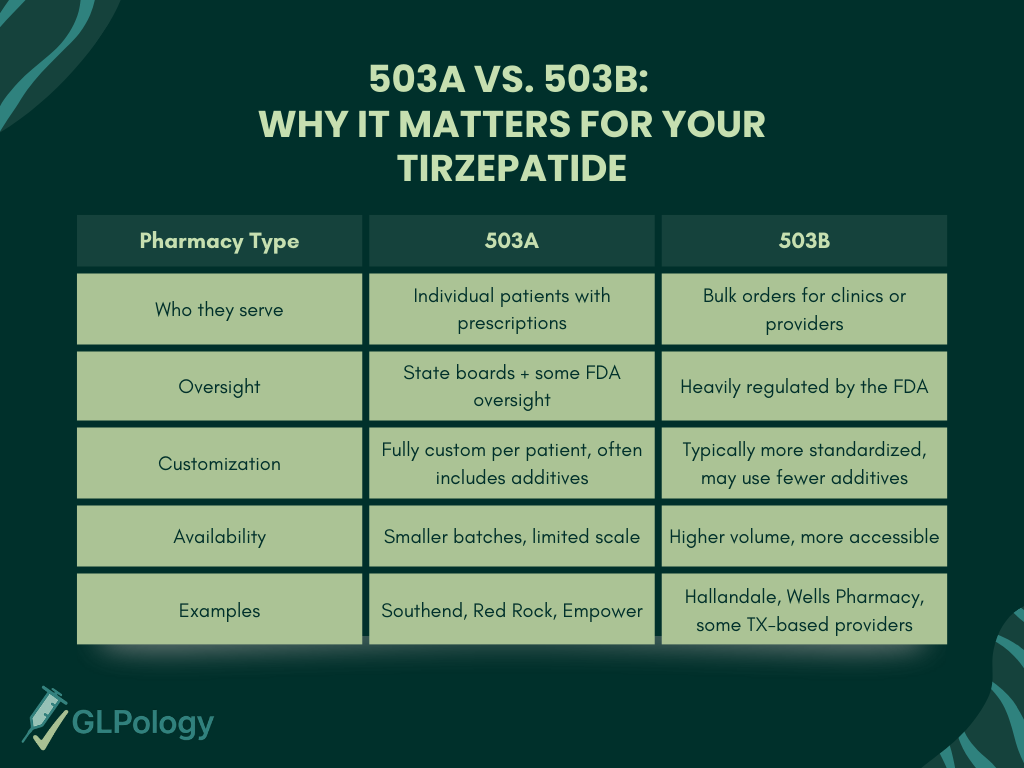How Additives in Compounded Tirzepatide Can Impact Your Experience
If you’re considering compounded tirzepatide for weight loss and blood sugar control, you’ve likely come across formulas that include additives like Vitamin B6, B12, niacinamide (B3), and glycine. These additives aren’t just filler—they can potentially enhance your experience or influence side effects, depending on your body’s needs.
But what do these additives actually do—and which one is best for you? Here’s what we know from science, prescriber guidelines, and community experience.
Why Additives Are Used in Compounded Tirzepatide
Tirzepatide, the active ingredient in Zepbound and Mounjaro, is sometimes compounded with other ingredients for various reasons:
-
To support energy levels
-
To mitigate side effects like nausea
-
To improve solubility or injection stability
-
To enhance metabolic or cognitive support
While Eli Lilly’s official Zepbound formula is standardized, compounded versions vary by pharmacy. Many compounders add vitamins or amino acids based on anecdotal outcomes and patient preferences. Let’s break down the most common ones.
Common Additives and Their Benefits
1. Vitamin B6 (Pyridoxine)
-
Why it's added: To reduce nausea, one of the most common side effects in early GLP-1 treatment.
-
What the science says: B6 has long been used to treat pregnancy-related nausea and motion sickness. Its role in neurotransmitter function also supports mood regulation.
-
Consider if you: Are sensitive to nausea or prone to motion sickness.
-
Backed by: American Family Physician on B6 and nausea
2. Vitamin B12 (Cobalamin)
-
Why it's added: To support energy levels and nerve health, especially in those on long-term metformin or with dietary deficiencies.
-
What the science says: B12 deficiency is common in those with insulin resistance or those following restrictive diets. Supplementation can improve fatigue and brain fog.
-
Consider if you: Are low in energy, vegetarian, or take medications like metformin or PPIs.
-
Backed by: NIH Fact Sheet on B12
3. Niacinamide (Vitamin B3)
-
Why it's added: For skin health and anti-inflammatory benefits.
-
What the science says: Niacinamide supports skin barrier function and can reduce inflammation, but in higher doses, it may cause flushing or worsen acne in sensitive users.
-
Consider if you: Are managing inflammatory skin conditions or want added antioxidant support.
-
Caution: If you have hormonal acne or are sensitive to skin triggers, monitor closely.
-
Backed by: Dermatology review of niacinamide
4. Glycine
-
Why it's added: To support muscle mass and recovery, especially during rapid weight loss.
-
What the science says: Glycine is an amino acid involved in tissue repair and metabolic regulation. It may also promote better sleep and reduce oxidative stress.
-
Consider if you: Are actively exercising, strength training, or want to preserve lean body mass.
Should You Choose a Formula Based on Additives?
The short answer: Yes—if you’re sensitive to side effects or want to optimize outcomes. However, always discuss this with your prescribing provider. Some may let you request a specific additive blend; others have fixed protocols based on supplier agreements (e.g., Empower, Strive, Red Rock, Southend, Trava, Ivy Meds, TX ProMed).
Here’s a simplified chart of commonly reported blends:

What’s the Deal with Additives, Really?
Before diving too deep into which additive is “best,” it’s important to understand why they’re being used at all.
Compounded tirzepatide is not FDA-approved—it’s created by pharmacies under special exemptions. These additives aren’t just for potential benefits. In many cases, they’re a strategic workaround to avoid direct copycatting of the commercial version (Zepbound or Mounjaro).
Most people don’t feel major effects from these additives at the low doses included in compounded formulations. But by slightly modifying the formula—like adding glycine or niacinamide—compounders can legally justify creating a different “custom” medication.
Community Insight:
Redditors and GLP-1 users commonly point out that these additives may do something, but they’re more likely included to maintain legal and regulatory compliance. So while you might notice a small energy boost or less nausea, don’t expect drastic changes.
503A vs. 503B: Why It Matters for Your Tirzepatide

Pro tip: Ask your provider where they source from and if the pharmacy is 503A or 503B—this can impact cost, customization, and perceived quality.
Final Tips Before Choosing
Review your own medical history – Do you struggle with nausea, fatigue, or acne?
-
Check interactions – If you're on medications like Adderall or Prozac, consult with your provider before choosing additives that affect mood or neurotransmitters.
-
Start low and monitor – Even at low doses, side effects like flushing or skin breakouts can appear. A trial month may help guide your preference.
-
Use a reputable provider – Not all compounders are created equal. Be sure they follow safe 503A/503B practices and have transparency on ingredients and sourcing.
Takeaway:
Resources & Community Insight
- GLPWinner Provider List – Community-reviewed telehealth and compounder list
- FDA Compounding Pharmacy Guidelines – For understanding 503A vs 503B pharmacies

